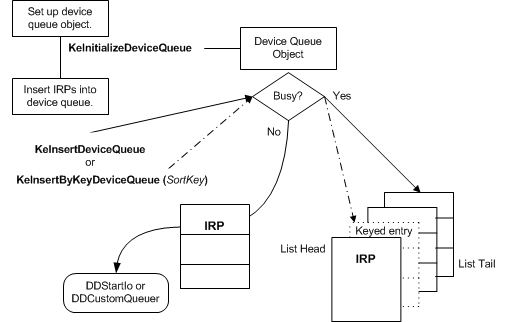Setting Up and Using Device Queues
A driver sets up a device queue object by calling KeInitializeDeviceQueue at driver or device initialization. After starting its device(s), the driver inserts IRPs into this queue by calling KeInsertDeviceQueue or KeInsertByKeyDeviceQueue. The following figure illustrates these calls.

As this figure shows, the driver must provide the storage for a device queue object, which must be resident. Drivers that set up a device queue object usually provide the necessary storage in the device extension of a driver-created device object, but the storage can be in a controller extension if the driver uses a controller object or in nonpaged pool allocated by the driver.
If the driver provides storage for the device queue object in a device extension, it calls KeInitializeDeviceQueue after creating the device object and before starting the device. In other words, the driver can initialize the queue from its AddDevice routine or when it handles a PnP IRP_MN_START_DEVICE request. In the call to KeInitializeDeviceQueue, the driver passes a pointer to the storage it provides for the device queue object.
After starting its device(s), the driver can insert an IRP into its device queue by calling KeInsertDeviceQueue, which places the IRP at the tail of the queue, or KeInsertByKeyDeviceQueue, which places the IRP into the queue according to a driver-determined SortKey value, as shown in the previous figure.
Each of these support routines returns a Boolean value indicating whether the IRP was inserted into the queue. Each of these calls also sets the state of the device queue object to Busy if the queue is currently empty (Not-Busy). However, if the queue is empty (Not-Busy), neither KeInsertXxxDeviceQueue routine inserts the IRP into the queue. Instead, it sets the state of the device queue object to Busy and returns FALSE. Because the IRP has not been queued, the driver must pass it on to another driver routine for further processing.
When setting up supplemental device queues, follow this implementation guideline:
When a call to KeInsertXxxDeviceQueue returns FALSE, the caller must pass the IRP it attempted to queue on for further processing to another driver routine. However, the call to KeInsertXxxDeviceQueue changes the state of the device queue object to Busy, so the next IRP to come in is inserted in the queue unless the driver calls KeRemoveXxxDeviceQueue first.
When the device queue object's state is set to Busy, the driver can dequeue an IRP for further processing or reset the state to Not-Busy by calling one of the following support routines:
KeRemoveDeviceQueue to remove the IRP at the head of the queue
KeRemoveByKeyDeviceQueue to remove an IRP chosen according to a driver-determined SortKey value
KeRemoveEntryDeviceQueue to remove a particular IRP in the queue or to determine whether a particular IRP is in the queue
KeRemoveEntryDeviceQueue returns a Boolean indicating whether the IRP was in the device queue.
Calling any of these routines to remove an entry from a device queue that is empty but Busy changes the queue state to Not-Busy.
Each device queue object is protected by a built-in executive spin lock (not shown in the Using a Device Queue Object figure). As a result, a driver can insert IRPs into the queue and remove them in a multiprocessor-safe manner from any driver routine running at less than or equal to IRQL = DISPATCH_LEVEL. Because of this IRQL restriction, a driver cannot call any KeXxxDeviceQueue routine from its ISR or SynchCritSection routines, which run at DIRQL.
See Managing Hardware Priorities and Spin Locks for more information. For IRQL requirements for a specific support routine, see the routine's reference page.